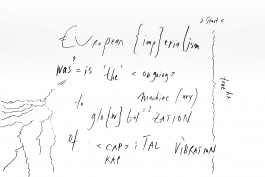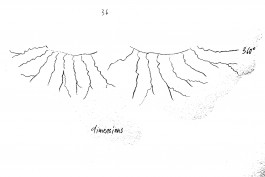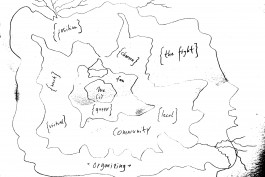AGF
Individual and collective listening, embracing dissonance, manifesting our humanity, imagining alternative futures.
AGF's manual for individual and collective listening introduces several exercises, activities and short texts of varying difficulty and complexity. While primarily concerned with listening, our perception, and our openness and ability to hear, they also beautifully incorporate elements of individual and collective practice and imagination, thus going beyond what comes to mind when someone mentions “listening exercises.”
A central idea here is that humans constitute the cells of one body, that we are all part of the same human body. These exercises aim to help us discover what this means for each of us individually, and for all of us collectively. We are all confronted with questions such as: What is collective listening? Does it even exist? If it does, can it help us overcome feelings of separation that seem to assault every single one of us (especially during the pandemic)? With AGF's guidance, we explore how our listening connects us to a deeper sense of self, to others, to our environment, and to our community.
Drawing on the writings of Susan Bickford, AGF also links the practice of listening to an attitude of “openness,” to a state of mind which consists in “being open to” things. Feeling safe is a prerequisite for attaining this state of mind, and that's one of the goals of these exercises, especially the earlier ones. They are short in duration, not dependent on location, and help us to view our environment from a different, perhaps less confrontational, perspective.
Ultimately though, a big part of AGF's practice is concerned with imagining alternative futures. Here, things are no different: through the later sonic meditations and spatial home listening exercises, we are encouraged to confront and embrace the surrounding dissonance, to bear and hold on to the unacceptable. By embracing the #sonicwilderness and analyzing its potential, we might be able to start perceiving sound as a growing entity, initiating connections, growing into decentralized networks operating outside the gender binary. #soundasgrowing is about initiating collaborative practice, about exploring sonic realities and creating feminist technologies.
Another dimension of letting the dissonance wash over us is letting go of our preconceived notions of what sounds good and - by extension - what is expected of us. The possibilities in this world are endless, but we are often restricted by the limits of our own imaginations. Creating, imagining, dreaming; those are fundamentally human attributes… In this era of mass corporations spoon-feeding us content they think we want while they exploit our physical and mental labor/existence, stifling our individual and collective imaginations is not just a random side-effect, it is one of their fundamental goals. If we are able to imagine alternatives, if we can dream of futures that seem outside the realm of possibility today, if we can create technologies and methods that don't conform to the status quo - these are actions that not only create possible positive futures for all of us (which in itself is a beautiful thing), but they also nurture the human in each and every one of us.
Adam Badí Donoval
#SONICWILDERNESS – MANUAL FOR INDIVIDUAL AND COLLECTIVE LISTENING EXERCISES
Shadow listening
… is the sun out
can you see your shadow?
can you sense the ghosts
hunting your edges
configuration of a nano swarm
time is the greatest of all warriors
listen to your shadows
how quiet it is throwing shade.

What is collective listening? Is it even possible to overcome our separation? Sometimes I imagine we are one body, all humans, just one body and that individuals are cells, more or less free-floating with some agency, but also trapped or stuck. The way we are separated as humans, like atoms in the same larger body of the human species, is intriguing. Is there collective consciousness? How does it work? Is our listening capacity connected to it?
Thinking a lot about what is human lately. In a virus-ridden cyborg-meta-morphing age of climate crisis effects I realise that everything we make is human. So, if that is true, we are not pre-determined – we are fluid and under constant re-definition or escape from being. I am fascinated by the ability of humans to dream, think, imagine… I imagine that large parts of our brains contain intelligence that is inaccessible.
INTRODUCTION
This collection is a series of exercises, thoughts, drawings and animations to inspire experimentation and make for challenging listening. Enjoy!
“… when I reflect on the actual practice of listening, I cannot escape the concept of openness. I cannot describe what I am doing when I am listening without coming back to some version of “being open to”, just as “closedness” seems the invariable characteristic of not-listening.”
(Susan Bickford: The Dissonance of Democracy - Listening, Conflict, and Citizenship)
Openness is risky and scary and requires safety. This blog is about finding spaces of safety and exercising your listening alone and with others.

1. Simple listening exercise, alone or together
find a safe spot
find a position to stay/sit/be still
close eyes
count to 36
stop counting
listen
identify all sounds around you
consider all dimensions
360 ° {perception}
below/above
open your eyes
pick one of these questions and answer them:
what is the quietest sound?
what is the loudest?
which sound is closest, which furthest away?
what is your favourite sound of all of them?
is there rhythm?
is there a sound that scares you?
is there a sound which you can’t tell what it is?
{next level – for advanced music producers}
imagine all sounds with a reverb on
imagine a high pass filter
filter certain frequencies
check the pan effect
2. Two ears and two hands, alone
stay still and try to close your ears without moving
just with your mind
most likely it is not possible
take your hands and close your ears, strongly
open, close them many times
now make a rhythm with opening/closing
this will work better in a loud environment
(if you are inside, play some music very loud noise music is best)

3. Inner listening and frequency massage, alone
close your ears with your hands
take a deep breath and hum loudly
until last breath is out
repeat 9 times
start changing the pitch/frequency of the hum
let the tone move around by slightly shifting your facial expression
in your inner head/resonance space
massage your skull with the vibration of your tone
(this exercise is also good against stress and anxieties, if you are stressed, repeat 4 times)
4. Taking a walk, with others
walk
take small portable devices of your choice
analogue or battery-powered
carry small speakers, synthesizers, bells, tablets, phones
(see list below)
walk, discover
listen and search for objects
spaces to "play with"
gather around...
start exploring sonically
touch, stroke, hit, drum
hum, use your body
listen to each other
list of gadgets, technology and techniques to use:
https://etherpad.wikimedia.org/p/sonicwildcode
…
add ether pad of apps here:
5. {sonic} TREEing
a sonic meditation, listening exercise
sonification process
alone or together
the sonic meditation (treeing) on frequencies (in Hz),
derived from Binti by @Nnedi
and also tree-breathing by @real_mkk
find a safe space in a forest, park, backyard, playground
lean onto a tree
listen
imagine the roots, the stem and the sky connected
breathe with the tree
imagine the roots are a very low frequency
imagine the tree crown is a high frequency
singing, sounding, moving
make a mathematical assessment
of the tree’s frequencies in Hz
where are the low, mid and high frequencies
potentially flowing, where is the sound?
listen, imagine and
meditate on the frequency
6. Spatial surround sound home listening exercise
MIXING & LISTENING
What is your relationship with dissonance?
create a multi-speaker set up in your home
find all speakers, portable, battery-powered, Bluetooth, etc.
use several different sound sources and connect them
computer/website, iPhone/app, radio,
place them around you or yourself within
play different pieces of music
move your body/ears around
move the speakers around
analyse
what is happening
how is your perception changing
how is your perspective affected
how are you perceiving dissonance
can you handle it
can you feel it
what do you feel?
try to hold on and bear the dissonance
the inacceptable
repeat frequently!!!!!!!

#soundasgrowing
if the score is the potential
of what can happen
a future possibility
think about sound GROWING
initiating connections
growing into decentralized networks
intersectional trans-corporeal-feminist
#sonicwilderness
collaborative practice
exploring sonic realities
and feminist technologies
If you need help with the exercises, want to explore any of the methods in more depth, or consult your techniques, do not hesitate to contact AGF directly at agf (at) poemproducer.com.
BIO
AGF aka poemproducer aka Antye Greie is a Finland-based artist and facilitator. She has published more than 30 records, facilitated countless online projects and organizes sound interventions with collaborators from around the globe. Her work deals with possible futures within and outside the artistic practice. AGF weaves deconstructed language, field recordings, low frequencies, disembodied voices, post-club aesthetics and interwoven arhythmical patterns into dense sonic feminist technologies.